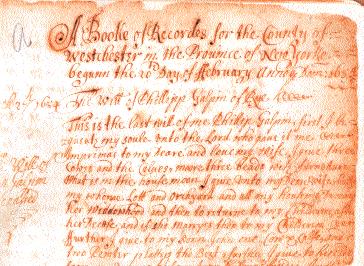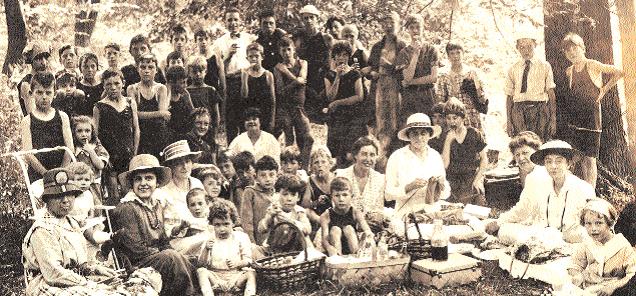On March 27, 1684, Phillip Galpin brought his will to be recorded by John Ryder, the first County Clerk for Westchester County. This will is the first full entry in “The Booke of Records for Westchester County,” the oldest surviving volume in the County’s collection (now known prosaically as Liber A of Deeds). Mr. Galpin surely had no idea his will would be the premier document of a collection spanning more than three centuries and be used by genealogical researchers worldwide.
The Westchester County Archives was established in 1984 as an offshoot of the County Clerk’s office, to provide proper storage for the County’s treasure trove of historic documents. The challenging task of bringing order to the records began in 1985 when the first archivist was appointed and humidity and temperature-controlled vaults were constructed in the new Westchester County Archives and Records Center. Thousands of hours were logged by staff and dedicated volunteers to accession, organize, rehouse, and index and describe hundreds of volumes and tens of thousands of paper documents. Equipment, such as microfilm readers and scanners, was acquired for patron use.
Four years later in 1989, the Reading Room opened to provide onsite space for public research of the records. That same year the Westchester County Historical Society moved into the Archives building. Researchers could then access both collections in the same space, and still do today. As the Archives contains County-level government records such as wills, deeds, and naturalization papers, and the Historical Society holds volumes of local history, periodicals and newspapers, the collections complement each other. Researchers are treated to a full array of both original and derivative source material dating from the late seventeenth century to the mid-twentieth century.
The most-sought-after Archives holdings for genealogy are those that link generations, especially the wills and estate files (probate records), marriage records, and the New York State Census. Other documents held by the Archives, such as deeds, naturalization applications, court records, school census reports, and Almshouse records may also show family relationships. Maps, incorporation records and other documents can help fill in details or provide leads when other sources prove elusive. Researchers will benefit from browsing the guide to collections on the Archives website and reviewing the chronological series index to 38 series of records that start in the 1700s.

Collection of the Westchester County Archives
Wills/Estate Files (Probate Papers)
For early probate holdings, 1664–1782, a volume of abstracts is available. Full records are available beginning after the Revolutionary War and run through 1921. Many estate files contain names of family members and witnesses, the date of the individual’s death, and sometimes place of death as well. The full index (1787–1983, series 171) is on microfilm, and is arranged alphabetically by last name, so it is not necessary to know a date of death. If the person does not appear in the index, researchers may have success searching for a parent to see if that person is listed in the mother’s or father’s will. A partial index is available on the Archives website and is a work in progress. Some of the early wills have been digitized for preservation purposes, as they are fragile, but generally, patrons will be able to see the original records, and take photographs, or have copies made. Records in the Archives include Estate Records (1775, 1782–1909) series 16 and Wills (1779, 1784, 1787– 1941) series 132.
Marriages
As birth, death, and marriage records in New York State are issued and kept at the local level (village, town, city) and/or state level, it is a bit of an anomaly that the county Archives has any marriage records at all, but the Archives does have marriage records from 1908 to 1935. There is a full index to the Archives’ marriage records on the website that includes both brides and grooms, arranged alphabetically by last name. Marriage records list the parents’ names for both bride and groom, and also give occupation, current address, age, birth country (rarely the town, however), and sometimes birthdate. (The Archives does not have any birth or death records.)
State Census
The New York State census for Westchester County is available on microfilm for the years 1905 (county original), 1915 (state original), and 1925 (state original). They are arranged by election district. The Archives does not have a census index, but most communities are small enough to search fairly quickly. FamilySearch.org has searchable name indexes. Ancestry.com provides access to images of the state original copies for the 1915 and 1925 censuses, both of which are indexed and searchable by name. The Archives holds the original county books (duplicate of state copies) for 1915 and 1925, but due to their fragile condition, they may not be available to the public. Researchers may wish to consult the copies in both places as one may be hard to read, obscured, incomplete, or the copies may not agree perfectly due to transcription errors.
Deeds
Deeds and the deed index from 1684 to 1966 may be accessed on the Public Viewer (no charge) in the Reading Room. The full index up to the present may be viewed online at Westchesterclerk.com, but researchers are required to set up an online account to look at the deeds. Original Deed Index Books are available up to 1907, series 34 and 108, and Deed Books to 1903, series 47. Deeds will often list husband and wife, and sometimes father and son, father and children, or other family members. An index of mortgages 1680–1897 is available in the Reading Room and a map collection is also available (some online).

Collection of the Westchester County Archives
Naturalizations
The earliest naturalization records date from May 24, 1808, but the most useful are those 1906 and later. The longer form came into use at that time that provides spouse’s name, applicant’s and spouse’s birth dates and places, marriage date and place, name of ship and port of arrival, previous residence, occupation, children’s names, birthplaces, current residences, and names, occupations, and residences of witnesses. Prior to 1906 naturalization forms contain little to no personal information. The index to naturalizations is online and complete up to 1928, and additional entries up to 1955 are in process. Records include Declaration of Intention Record Books (1855– 1906) series 6; Naturalization Petitions (1895– 1991) series 11; Naturalization Record Books (1844–1906) series 13; Naturalization Petitions, Rejected (1898–1906) series 14; Naturalization Records, Miscellaneous (1808–1924) series 15; Naturalization Repatriation Proceedings (1937–67, bulk 1941–42) series 287.
Court Records
Court records from the eighteenth and nineteenth centuries can place an individual at a certain point in time, and give some idea as to their activities and status in society. Some name fathers and sons, or husbands and wives. Many, however, are only pieces of larger files. These pieces are indexed on the website by last name. Full Supreme Court files and Special Proceeding case records begin in 1847 when the court system was reorganized and continue up to 1911. These are indexed alphabetically by last name of the plaintiff. This index is not available online.
Other court records include the Court of Sessions Minutes (1684–1895) series 43, the Court of Common Pleas Minutes (1710–1846) series 9, and the Board of Supervisors’ Minutes (1772–1930) series 215, and Proceedings (1772–1969, which include election results) series 145. These records are either not indexed or are minimally indexed, requiring the researcher to painstakingly read hundreds of pages of mostly handwritten text. But the payoff is when a nugget of important information is found!
School Census Reports
The Archives has school reports for most communities in Westchester from 1828 to 1968, with gaps. Of particular interest are the school district censuses, which list either all of the children in the family attending school or the name the father (or mother, if the mother was the head of the household) and the number of children in that family attending school. An index of extant reports by community is available online.
Almshouse Records
One can sometimes find, sadly, entire families listed as residents of the County Almshouse. The records between 1875 and 1908 contain the most information, including parents’ names, physical condition of the person, reason for entry, and dates of repeat entries. There is an index, alphabetical by last name, in the Reading Room.
Maps
The Archives houses all the maps filed with the Westchester County Clerk from 1766 to the present including some Sanborn fire insurance maps, plus several atlases that show property ownership. Maps are a vital tool for locating families and individuals, and many show locations of buildings on properties. Comparing maps from various years reveals the development of a community over time. Some atlases, including the Atlas of Westchester County, 1881, are digitized and can be viewed on the website.
Incorporations
Incorporation records beginning in 1876 give names of local businesses including fraternal and religious organizations, owners’ names, and purpose and location of the business. These are indexed online alphabetically by business name and the name of owner. Early religious incorporations are available in a separate series from 1784 to 1909.
Veterans’ Cemetery Records
The Works Progress Administration (WPA) Survey – Veterans’ Cemetery Records, Revolution to World War I (series 81) provide the burial place and often some details of a veteran’s service record. They can be viewed on the website: (http://collections.westchestergov.com/cdm/landingpage/collection/vetcards).
Historic Buildings Inventory Forms
For those researching a historic house or the history of a property, this survey of buildings that are not on the National Register may be of use. The records may include a photograph, building dimensions, and architectural details. They are indexed by street and community on the website.
Other Records
Additionally, there are records with a specific focus, generally of use as informal censuses for individuals whose families owned land and have lived in Westchester County for more than a century. These include the Commissioners of Forfeiture (1783–85), abstracts of sales of land confiscated from Loyalists; the New Receipt Booke of 1714, receipts for taxes paid in Mount Pleasant and White Plains, and the Road Commissioners’ Book (1718–71), an overview of land surveys for new roads.
Visiting and Hours
The Archives asks all patrons visiting the Reading Room to fill out a registration form and place all personal items not needed for research in a locker. Patrons are allowed to bring in notes, a notebook, laptop or tablet, and digital camera. Only lead pencils are allowed as they are safer for original documents; no pens or mechanical pencils are to be used. Staff make all photocopies, which are 50 cents per page; scans of fragile documents or pages from oversized books are $2 per page. The Westchester County Archives and Records Center is located at 2199 Saw Mill River Road in Elmsford, NY. Parking is free; the Archives is also accessible by bus and by taxi from the White Plains MetroNorth train station. Directions are available on the website. The Archives Reading Room is open to the public Tuesdays and Wednesdays, 9 a.m. to 4 p.m., except Federal holidays and Election Day. Appointments are not necessary, but visitors are strongly encouraged to call ahead and confirm especially if traveling from a distance.
Contacting Us/Website
As the collections do not circulate, the Archives staff will do research for patrons who cannot travel to the Archives. The website has information on ordering copies of records or custom research, and fees: westchestergov. com/wcarchives. Researchers can also direct email queries to the Archives Reference Desk through the website, or call the Archives at (914) 231-1500.
by Graziano, Jackie
Originally published in The New York Researcher, Spring 2004
© 2014 The New York Genealogical and Biographical Society
All rights reserved.